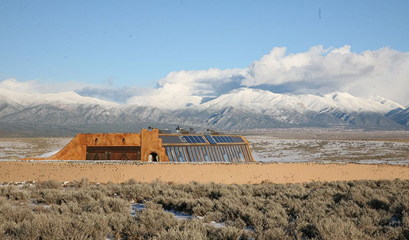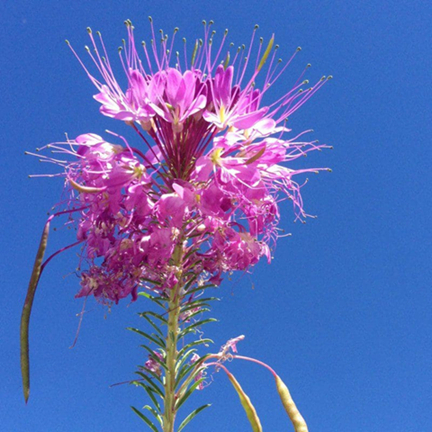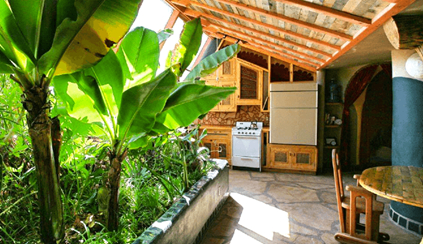
Home >> Newsletters > GreenFriends Newsletters > Q2 2024 Newsletter
| Home | Source Reduction | Friends of Green Friends | Newsletters |
| Gardening | Resources | What You Can Do | Embracing The Trees |
| Living Off The Grid |
 Earthship outside of Taos, NM |
|
In Taos, New Mexico, on a sage mesa, the directions to my home were: Go over the Gorge Bridge, after two miles turn right at the tree. It was the only tree, and we named our street, “Lone Tree Lane.” I lived in an Earthship, an off-grid home invented by Taos Architect Michael Reynolds. My home was in an Earthship community on about 400 acres. In 1994 or so, only a few of the homes in this newest of Michael Reynolds' three Earthship communities were ready for occupancy, and mine was one of them. When friends visited for the first time, they were often visibly moved, sometimes catching their breath in awe. Many found it like coming upon an oasis when they would enter the large spacious living room with its huge planters - a lemon tree, hibiscus, jasmine, rosemary, and such - that lined the floor to ceiling south-facing windows. The roundness of the inside and the warmth of the adobe made it feel like you were in the arms of Mother Earth. And the silence was palpable. Everything about Earthships, just about, is Earth-friendly. They are built partially down into the ground with sides of the dugout becoming part of the walls and then with used tires filled with dirt and laid down like bricks the rest of the way up. Each tire weighs about 300 pounds. The labor is intensive. (I’d choose strawbale and all the same off-grid methods and adobe plastering, if I were to build again). Then the inside is plastered with adobe mud. The outside from the north looks like a little hill, with dirt and grass growing on the berms. This page on the Earthship website shows photos that most closely resemble my Earthship home. As you’ll note on the main website, some of the buildings have become quite fancy in design compared to the more basic floor plan. The roof is made of a special non-toxic material and is designed to catch water which pours into a 3,000-gallon cistern inside the house, in a space between the bedroom and living area. Mine had a little waterfall that turned on when the sun rose, operated by a solar panel - this kept the water fresh. Water was pumped into the kitchen and shower faucets. Drinking and cooking water was filtered. Gray water was piped into the planters. I had someone build a small pond outside in front where the water overflow from summer monsoons kept it full. Goldfish grew large and lily pads offered shade and shelter. A black snake found the Goldfish tasty and that was the end of that. For electricity, there were solar panels across the front, just above the ceiling to floor windows. These powered DC for light and refrigerator. I loved the gentle feeling of AC lights and the silence of the refrigerator. As I mentioned, there is a downside to being off the grid, most particularly the use of solar panels - batteries are essential, high maintenance, and upside is that they are recyclable, if you can find where. I rarely had to use the fireplace in winter, even at below freezing outdoors temperatures, as the adobe walls gathered heat during the day. The south-facing windows were critical for light and for heat and for plants. My composting toilet made great fertilizer. A friend dug holes and I’d empty the contents along with food scraps, into the holes and then when full, covered them with dirt. After a few months, it was the most amazing compost I’ve ever used. But, yes, there was a huge "but" in my planting dreams. The mesa was windy and the dugout area in the front would flood during monsoons. I tried everything to get grass growing on the berms or whatever native plants might enjoy this setting. I did manage a small patch of bright green grass on the berm in front of the windows and discovered to my delight just how amazing my compost was. Then I planted something called the Rocky Mountain Bee plant on that front berm - gorgeous lavender flowers and long legume-like seed pods. It has medicinal qualities including use for stomach aches and sore eyes. The birds that were tall enough to reach the edible pods, loved them. It was fun to watch the birds point their beaks upwards and then jump to grab a pod. Later, along my walks, I found these flowers growing elsewhere on the mesa - the birds had planted seeds in their poop. I found this to be a great testament to our beloved Amma’s seed ball project, as such plantings will spread far and wide, by wind and birds. |
 Rocky Moutain Bee Plant |
| Top Naturally, I needed ways to store my food. I tried my best to buy only items in glass jars or bottles, and I used only glass jars for storage. I was inspired to stay aware of the horrors of plastic waste when I read about the Great Pacific Garbage Patch (GPGP), one of a few soupy parts of the ocean made up of discarded plastics - from large items to micro. Apparently the GPGP has about "79,000 tons of ocean plastic floating inside an area of 1.6 million sq km (618,000 sq miles)... This is twice the size of Texas, or three times the size of France." Recycling and reducing plastic production will be key in limiting garbage patches. There is an international plastics treaty which will be negotiated in 2024. To this day, I use mostly glass jars and bottles, and always recycle my plastics and urge others to do the same. Of course, another advantage to my Earthship was the small community. Right across Lone Tree Lane from me, a young woman was building her own Earthship, mostly by herself. We helped each other in various ways - including sharing food items - and we had nice chats. Down the lane a couple was also still in the building process. They enjoyed that I had one of the first cell phones, a huge and heavy thing that only worked if it was near the window. I used it rarely. This couple had kids and were comforted knowing they could use my phone in an emergency. And Michael Reynolds "office" was in an Earthship just down the road - I was friendly with him and his staff. |
 Rio Grande Gorge Bridge |
| Swamiji Dayamritananda Puri visited one time to give a retreat in my Earthship living room. Swamiji at the time served as head of Santa Fe ashram in New Mexico, and now he lives in San Ramon ashram and is the director of M.A. Centers in North America. His retreat got a huge front page publicity write-up in The Taos News.
About 30 people showed up. Great success. Not long after, my dog Delilah, a sweet Old English Sheep dog mix, died at age 13. Under a full moon, my neighbor and I buried her out back, piling large rocks on the grave to protect it from coyotes. Soon, Swamiji contacted me and said that now that my dog was gone, I could move into the Santa Fe ashram. With Amma’s Grace, and a bit of amazing Cosmic Wonder, our beloved Amma found me a buyer right away. And so it was that my Earthship days were over. Savitri - Olympic Peninsula, WA |
 Inside an earthship |
Read Beauty in a Backyard Compost in the Q2 2024 Newsletter >>
| Home | Source Reduction | Friends of Green Friends | Newsletters | Resources | What You Can Do | Embracing The Trees |
For more information, e-mail info@greenfriendsna.org |
||||||